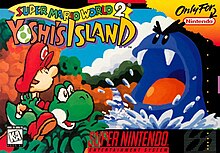
Back سوبر ماريو ورلد 2: يوشيز آيلاند Arabic سوبر ماريو ورلد 2: يوشيز آيلاند ARZ Super Mario World 2: Yoshi’s Island Byelorussian Super Mario World 2: Yoshi's Island Catalan Super Mario World 2: Yoshi's Island Czech Super Mario World 2: Yoshi’s Island German Super Mario World 2: Yoshi's Island Spanish Super Mario World 2: Yoshi’s Island Finnish Super Mario World 2: Yoshi's Island French האי של יושי HE
| Super Mario World 2: Yoshi's Island | |
|---|---|
 North American cover art | |
| Developer(s) | Nintendo EAD Nintendo R&D2 (GBA) |
| Publisher(s) | Nintendo |
| Director(s) |
|
| Producer(s) | Shigeru Miyamoto |
| Designer(s) | Yasuhisa Yamamura |
| Programmer(s) | Toshio Iwawaki |
| Artist(s) | |
| Composer(s) | Koji Kondo |
| Series | |
| Platform(s) | Super NES, Game Boy Advance |
| Release | Super NESGame Boy Advance |
| Genre(s) | Platform |
| Mode(s) | Single-player, multiplayer |
Super Mario World 2: Yoshi's Island[a] is a 1995 platform game developed and published by Nintendo for the Super Nintendo Entertainment System (SNES). It is the sequel follow-up to Super Mario World. The player controls Yoshi, a friendly dinosaur, on a quest to reunite baby Mario with his brother Luigi, who has been kidnapped by Kamek. As a Super Mario series platformer, Yoshi runs and jumps to reach the end of the level while solving puzzles and collecting items with Mario's help. The game has a hand-drawn aesthetic and was the first in the franchise to have Yoshi as its main character, where it introduces his signature flutter jump and egg spawning abilities.
After four years of development, Yoshi's Island was released in Japan in August 1995 and worldwide two months later. Some of its special effects were powered by a new Super FX2 microchip. The game was ported to the Game Boy Advance as Super Mario Advance 3: Yoshi's Island in 2002. This version was rereleased for the Nintendo 3DS and the Wii U's Virtual Console in the early 2010s. The original version was also released for the Super NES Classic Edition and Nintendo Switch Online in the late 2010s.
Yoshi's Island received critical acclaim and sold over four million copies. Reviewers praised the art, sound, level design, and gameplay, and acclaimed Yoshi's Island as a masterpiece and one of the greatest video games of all time. The game brought newfound renown to both Yoshi as a character and Shigeru Miyamoto's artistic and directorial career. The distinct art style and Yoshi's signature characteristics established the Yoshi series of spin-offs and sequels. The game would be the last Super Mario platformer before the series' transition to 3D gameplay, with no further 2D entries for over a decade.
- ^ "Super NES review". Nintendo Magazine System. No. 33. Australia. December 1995. p. 26.
Cite error: There are <ref group=lower-alpha> tags or {{efn}} templates on this page, but the references will not show without a {{reflist|group=lower-alpha}} template or {{notelist}} template (see the help page).